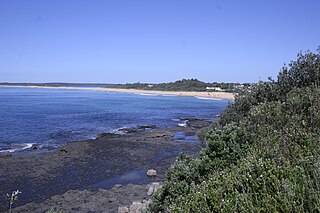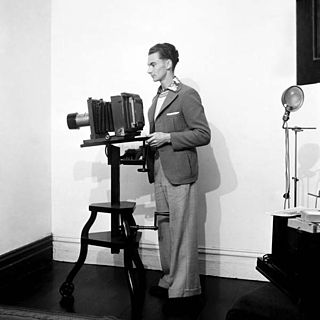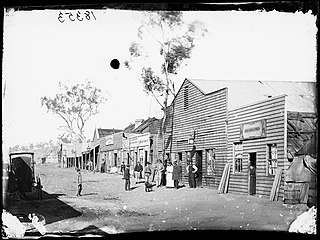
Maxwell Spencer Dupain AC OBE was an Australian modernist photographer.

Culburra Beach, commonly referred to as Culburra, is a town located in the South Coast region of New South Wales, Australia. Located within the Shoalhaven local government area, the town is 18 kilometres (11 mi) east-southeast of Nowra on Jerrinja Wandi Wandian Aboriginal Country. At the 2016 census, the town had a population of 2,874 and is the regional centre for the coastal villages of Currarong, Callala Beach, Callala Bay and Orient Point.

Photography in Australia started in the 1840s. The first photograph taken in Australia, a daguerreotype of Bridge Street, Sydney, was taken in 1841.

Sunbaker is a 1937 black-and-white photograph by Australian modernist photographer Max Dupain. It depicts the head and shoulders of a man lying on a beach in New South Wales, taken from a low angle. The iconic photograph has been described as "quintessentially Australian", a "sort of icon of the Australian way of life", and "arguably the most widely recognised of all Australian photographs."
David Moore was an Australian photojournalist, historian of Australian photography, and initiator of the Australian Centre for Photography.
Jeff Carter was an Australian photographer, filmmaker and author. His work was widely published and contributed iconic representation of the working population of the Australian bush as self-sufficient rugged and laconic.

George Caddy (1914–1983) was an Australian dancer and photographer. Caddy emerged as a significant photographer of social activities on Bondi Beach in his day, only when hundreds of his photographs were re-discovered in 2007, among them the only existing documentation of an historic beach acrobatic club.

Olive Cotton was a pioneering Australian modernist photographer of the 1930s and 1940s working in Sydney. Cotton became a national "name" with a retrospective and touring exhibition 50 years later in 1985. A book of her life and work, published by the National Library of Australia, came out in 1995. Cotton captured her childhood friend Max Dupain from the sidelines at photoshoots, e.g. "Fashion shot, Cronulla Sandhills, circa 1937" and made several portraits of him. Dupain was Cotton's first husband.

Henri Marie Joseph Mallard was an Australian photographer.
Candid Camera: Australian Photography 1950s–1970s was a group retrospective exhibition of social documentary photography held at the Art Gallery of South Australia from 28 May to 1 August 2010.
Robert McFarlane was an Australian photographer and photographic critic.

Cecil Westmoreland Bostock (1884–1939) was born in England. He emigrated to New South Wales, Australia, with his parents in 1888. His father, George Bostock, was a bookbinder who died a few years later in 1892.

The Holtermann Collection is the name given to a collection of over 3,500 glass-plate negatives and albumen prints, many of which depict life in New South Wales goldfield towns. It also includes numerous photographs of Australian rural towns and the cities of Sydney and Melbourne taken between 1871 and 1876. The collection is held by the State Library of New South Wales.
Ruth Maddison is an Australian photographer. She started photography in the 1970s and continues to make contributions to the Australian visual arts community.
Sandra Edwards is an Australian photographer. Edwards specialises in documentary photography and photographic curation. Born in Bluff, New Zealand in 1948 Edwards arrived in Sydney in 1961. Edwards was at the forefront of a group of progressive photographers in the 1970s and 80s who were driven to create documentary work that recorded social conditions and had the intent to change these conditions. Edwards' work largely drew from feminist ideals and the media's representation of women as well as the portrayal of Aboriginal communities in Australia.
Gerrit Fokkema Born in Port Moresby, Papua New Guinea in 1954 and moved to Australia in 1958.

Barcroft Capel Boake was an Australian photographer. He is most famous for his mosaic of the New South Wales Contingent produced in 1885 which represents the soldiers returned from the war in Sudan.
Laurence Craddock Le Guay, was an Australian fashion photographer.
Light Vision was a bi-monthly Australian photography magazine that existed between 1977 and 1978.

John William Lindt (1845–1926), was a German-born Australian landscape and ethnographic photographer, early photojournalist, and portraitist.











